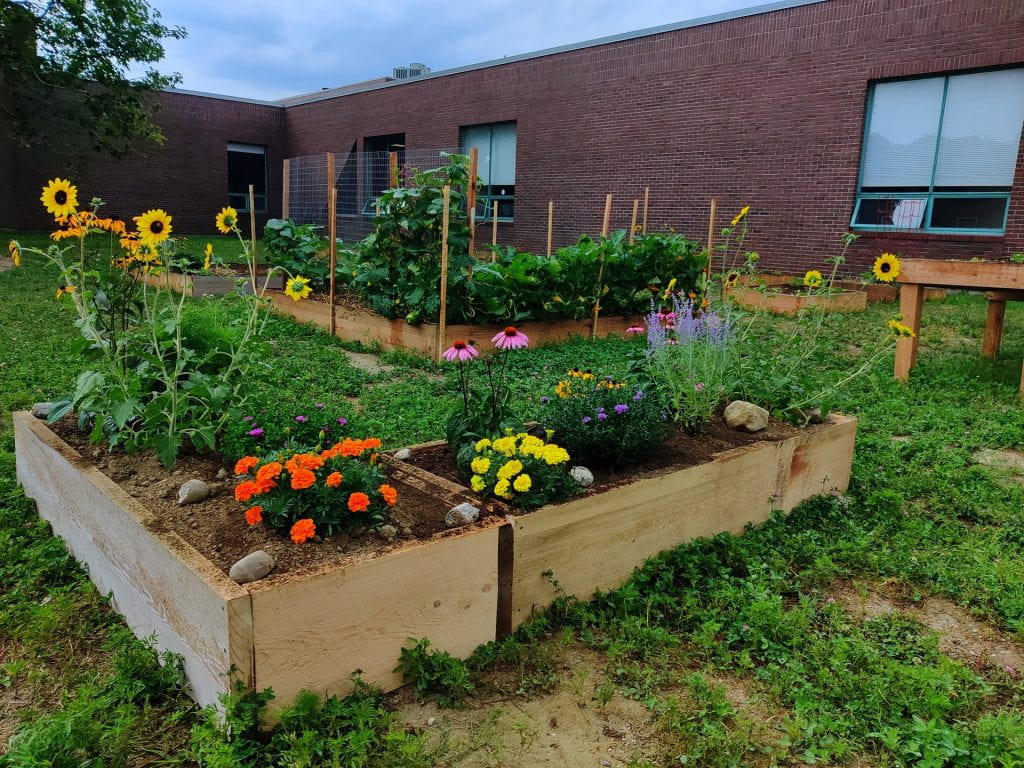Nov 1, 2021 | Feature |
By Annie Newman, Staff Writer
Even in October, the garden that sits next to the Student Olsen Center is teeming with life. Brilliant flowers bloom, vegetables ripen, and bees take pollen to ready themselves for winter. Students mill about, especially those that are in the “Dig It: Gardening for Change” class hosted by student advisor and teacher Gretchen Legler.
“What we do is we read people who are writing about how we need to change the way we grow food in America and across the world to make it less fossil-fuel dependent– so how we need to change the way we grow food and how we change the way we make food available to people,” Legler explained.
As well as reading and studying methods of change, students also work in the garden and donate the produce to put their lessons into practice. “We’ve worked in the garden, we planted things, we’ve nurtured things, we harvested things, and delivered them to [Saint Joseph’s] Nutrition Center, which is just up the street and is a free place for people to go 24/7 to get nutritious fresh food,” Legler said. St. Joseph’s Nutrition Center is also available to students.
Those that were on campus before the garden arrived may remember the Creative Writing building that stood next to the Student Olsen Center. But how did the garden come to be? “The garden was made possible by a grant from something called the Ella Lyman Cabot Trust,” Legler said. “It’s a Boston-based organization that likes to fund projects that help change the world for the better with an environmental focus. All of the wood here, the topsoil, the seeds, the greenhouse– it all was because of that grant.”
Legler has also detailed the different kinds of vegetables, herbs and flowers being grown in the garden: catnip, gourds, marigolds and more. “All of the work that has been done in this garden has been done by students. All of the building of the beds, the filling the beds with soil, starting all the plants, planting everything, taking care of it over the summer– it’s all been done by students,” Legler noted. Though deer have been nibbling at the growth that has been uncovered by the netting, the garden is considered a great success.
“I want people to know that they can come to the garden anytime and enjoy it,” Legler added. Most of the produce is reserved for food banks such as St. Joseph’s Nutrition Center and soon the Thrifty Beaver, but the garden is a good place to look at the growth and “rejuvenate your soul,” as Legler puts it.
If you are interested in an apprenticeship or work-study around the garden, contact Gretchen Legler at: gretchen.legler@maine.edu.

Nov 12, 2020 | Feature |
by Faith Rouillard, Contributing Writer

The New UMF Community Garden (Photo courtesy of UMF Community Garden’s Facebook page)
Yellow, pink, red, and purple… the colors of the UMF campus garden have begun to emerge. In the Fall of 2019, a construction crew made their way onto the UMF campus. Questions filled the air, “Why are they taking down the creative writing house?” and, “What will take its place?” The old, disheveled building was leveled and grass was planted in its absence. Luckily, this space didn’t remain empty for long.
Students on campus have spent many hours in the garden making it what it is today. Some classes have been planting flowers. Jessie Minior’s ‘Field Methods’ class has been studying the microclimate of the garden; whereas other courses such as, ‘Dig It: Gardening for a Change,’ goes to the garden once a week for experiential learning. Gretchen Legler, Assistant Professor of Creative Writing, applied for the grant that funds the garden.“Students are learning about things they’ve never learned before,” said Legler. “It has provided an experiential way for students to learn about sustainability. It has been really wonderful.”
In summer 2020, work initiative students, Sara Taylor and James Cooke, spent their time building the garden beds, filling them with soil, planting, and harvesting once a week. They filled the beds with parsley, sage, onions, lettuce, arugula, beets, radishes, tomatoes, squash and more.
The garden operates with many important goals: “Producing food for the community, providing classroom space, providing an aesthetically pleasing space on campus, providing flowers and herbs as a home for pollinators, and overall excitement for the community,” said Legler. “A big success has been a bridge between the campus and the community. One way to gauge its success is it’s providing a space for happiness, hope, and delight in a time that is incredibly hard on people.”
At the end of the growing season, the campus garden will have made eight donations of food to the Farmington community. The garden has donated over 100 pounds of food to St. Joseph’s Church, Old South Church, Wilton Food Bank, Fairbanks Food Pantry, and the UMF community. “It has been a terrific and unexpected success,” said Legler.
“My impression is that students are very excited about the garden,” said Legler. ‘Dig It’ student, Sava Nappi, said, “Every school I have been to has had a garden. This is something I assumed would already be here, so I have really enjoyed it.” The students aren’t the only ones who enjoy the garden though. “I am nearing the end of my teaching career, and this garden breeds new life into my job, so it is very meaningful to me,” said Legler.
The garden provides a welcoming space for all. It includes an accessible elevated garden bed for individuals who may not be able to bend over or those who may be in a wheelchair. There will be an open house for the garden on Tuesday, October 27th from 12 p.m. to 1:30 p.m. for UMF community members.

